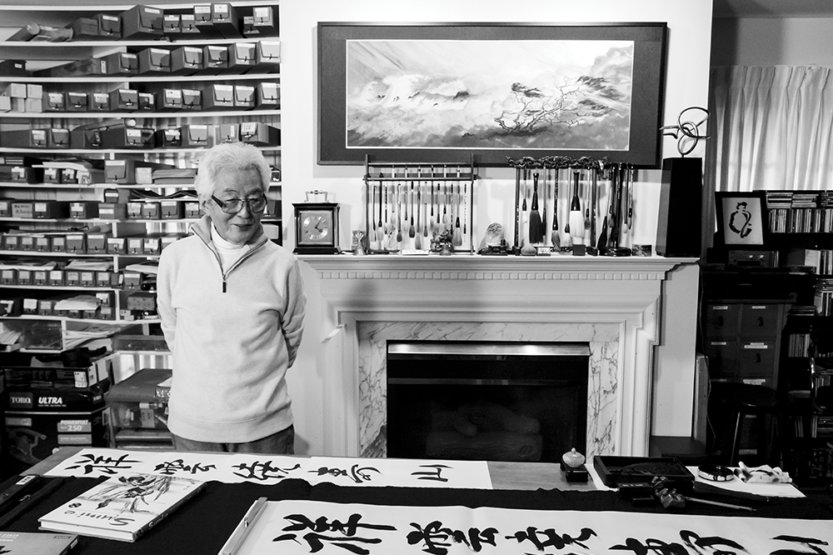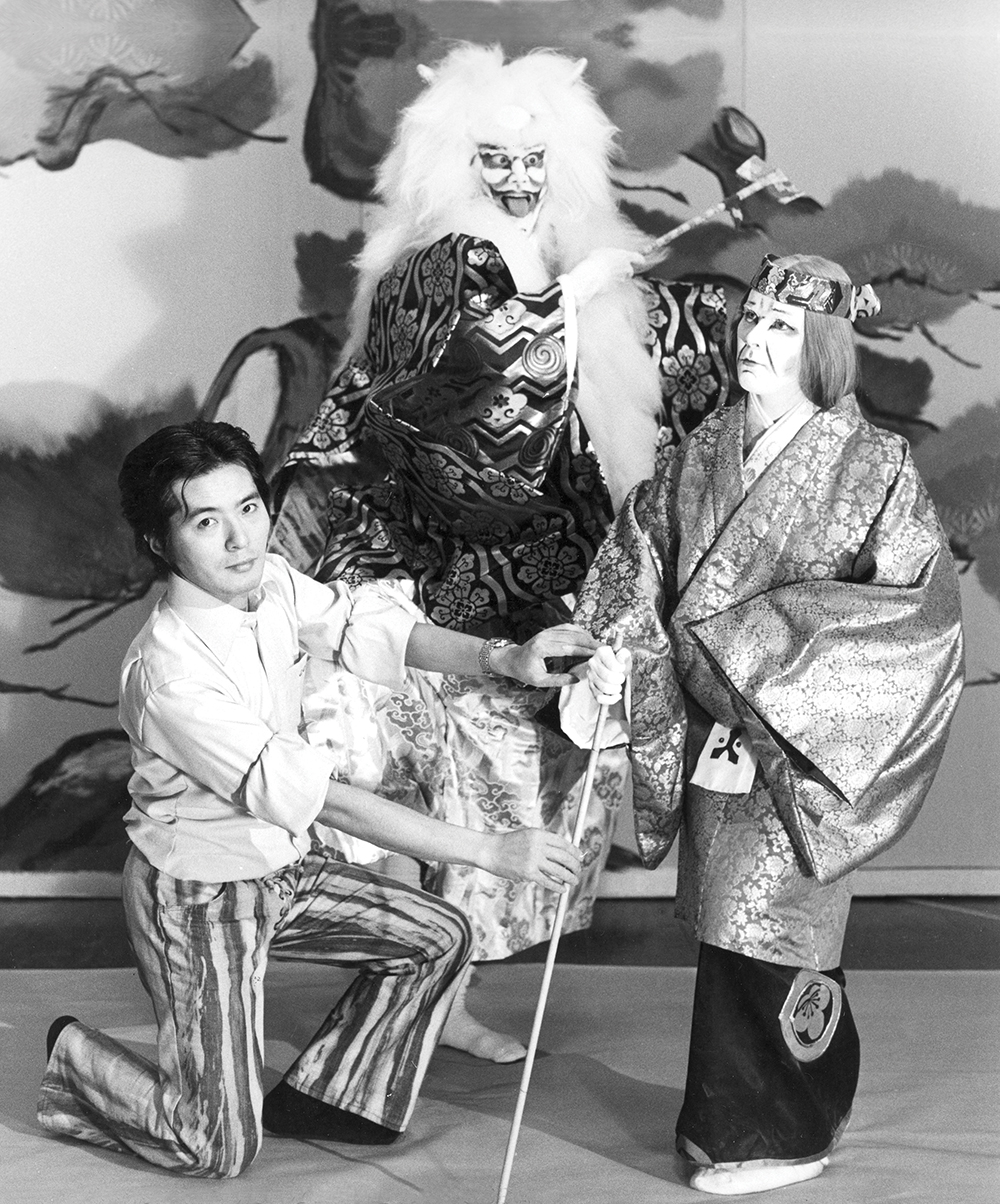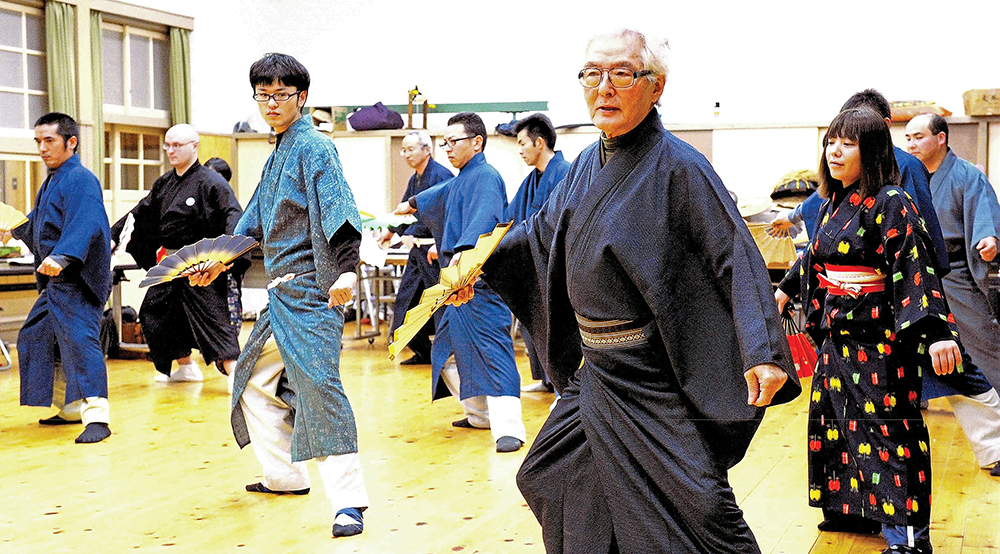Way of the Sensei
 Shozo Sato at his home studio (By Jarvis Kim of Adjacency, courtesy of Japan House)
Shozo Sato at his home studio (By Jarvis Kim of Adjacency, courtesy of Japan House) Shozo Sato, HON ’99, still remembers the searchlights sweeping across the sky over Osaka, Japan, in 1945. Then came the B-29 bombers.
“I could hear the planes coming in, the very deep propeller sounds,” says the University of Illinois professor emeritus, who was 11 years old at the time. The first bombs were incendiaries, and they created a massive firestorm that blazed across Osaka.
“We were all out on the street, helping people escape from the fire,” Sato says. Most vividly, he witnessed a young mother crawling beneath the roaring flames with a baby strapped to her back. She was suddenly horrified to discover that her baby had fallen from her back.
“She screamed her baby’s name and wanted to jump back into the fire,” Sato says. “Everybody held her legs and arms to stop her, against the big red flames and the dark and the smoke. I cannot get away from this image.”
Today, Sato is best known for expressions of peace and tranquility—the very opposite of that night in Osaka. He taught some of the most popular classes on the Illinois campus—sumi-e (ink painting), ikebana (flower arranging), shodo (calligraphy) and chado (ceremonial tea service). He also founded Japan House, an idyllic escape located on the southeastern corner of campus.
But Illinois was still far off in Sato’s future when he was growing up in Osaka. His father was originally from Hiroshima, and after the first atomic bomb hit that city on Aug. 6, 1945, Sato and his father wanted to find out if any relatives had survived. So they traveled 12 hours by freight train to Hiroshima, where they found nothing standing but the skeletons of buildings. When they went to the place where Sato’s father had grown up, they discovered that the bomb’s incredible heat had peeled the skin off of the granite stone on the gate, exposing stark white rock below.
“My father never found any of his family,” Sato says.
Because most buildings, including hotels, had been destroyed, Sato and his father camped on the ground for several weeks, unaware of the high levels of fallout particles. The radiation poisoning left Sato unable to have children of his own.
That’s one reason why teaching became his life, he says. “I cannot have kids, so why not take on young people’s education?”

Clockwise: Sato’s kabuki stagings of Western classics—shown here, Kabuki Othello—have won critical praise and toured the world; Sato brought “the soul of Japanese culture” to the U of I via lessons in ikebanna (flower arranging, top); and chado (ceremonial tea service, bottom). (Color image courtesy of Japan House; black and white images courtesy of UI Archives)
In the Japanese tradition, the professor-student relationship is more like a parent-child relationship. As he points out, “The relationship is for a lifetime.”
One of Sato’s “relationships for a lifetime” has been with Nick Offerman, ’93 FAA, who played the hilariously deadpan character of Ron Swanson on the popular TV show Parks and Recreation. Offerman still sees Sato as his sensei (mentor). That’s why in 2003 he asked Sato to officiate his wedding with actor Megan Mullally, best known for her role of Karen on Will & Grace.
Sato and his wife, Alice, “were the most incredible two-person army,” says Offerman, who performed in Sato’s acclaimed kabuki theater productions at Illinois. The shows had a family atmosphere, as rehearsals ran late into the night, culminating in feasts for up to 30 students.
“Shozo was a historian and artistic theory teacher, but he was also like a sports coach in teaching us dancing,” Offerman continues. “He designed the lights, scenery and costumes, and he taught us how to apply the makeup. And Alice was right there, covering everything with him.”
Sato’s love of traditional Japanese art began at age 4, and in school he would often ditch his math and science courses to sneak into art classes. But his passion for beauty did not make him popular. “When I was in the fourth or fifth year of primary school, the teacher asked everybody what they wanted to become when they grew up,” he reflects. “I was the only one who said ‘artist.’ Boy, did I get beat up.”
While attending high school and the university, Sato concentrated on visual and performance arts, and then he started teaching art for free at an orphanage for the children of American GIs and Japanese women. His big break came when the three superintendents of the American Navy, Army and Air Force school systems in Japan decided to support his work financially. Their support allowed him to study traditional Japanese art and eventually bring “the soul of Japanese culture” to the U.S. as a cultural ambassador.
An invitation to the U of I
Dance professor Margaret Erlanger was in Japan for six months of research as a Fulbright scholar when she heard about this young man running an art school in Kamakura. She went to his class every day for two weeks, taking notes. Before she returned to the States, Erlanger asked Sato if he would be interested in doing similar teaching at the U of I.
An invitation to teach as a visiting artist soon followed, and Sato arrived at Illinois in 1964 as one of the first Asian professors in the humanities and one of the few Asians on campus. He remembers people pointing to him as he walked down Green Street and saying, “Oriental.”
Sato became an assistant professor in 1967, and his classes in Japanese arts soon became extremely popular. “Word on the street was that he taught the coolest class in the curriculum,” Offerman says. “He was a rock star and anybody who had their head on straight wanted to get into sensei’s class. I can’t believe the patience he exhibited in teaching a bunch of rotund Midwesterners his beautiful and lithe art forms.”

“In kabuki, the stage is like a beautiful painting, and everything is stylized and exaggerated,” says professor Shozo Sato (left), who came to the University in 1964 from his native Japan. (Courtesy of UI Archives)
In 1969, Sato began what became a long tradition of performing kabuki, with its elaborate staging and magnificent costumes that weigh close to 100 pounds. The term comprises three words—ka (song), bu (dance) and ki (skill or art).
“In kabuki, the stage is like a beautiful painting, and everything is stylized and exaggerated,” Sato says.
“It’s a very presentational style,” Offerman adds. For more than 300 years, the tradition has been that only men perform the parts and they play any kind of role—from a terrifying military general to an 8-year-old girl. For instance, Offerman says that a terrifying general is conveyed through “the prescribed traditional walk and gesticulation, your vocal quality and the way you put together your phrasing. And if I do a mincing little walking style and use shy gestures, the audience says, ‘Oh, what an adorable 8-year-old girl.’”
Initially, American audiences were so confused by this exaggerated style that Sato says his first performance at Illinois was greeted with laughter. From that point on, he began every program by explaining the kabuki art form to the audience.
Offerman’s first role was as Soldier #2 in Kabuki Achilles—a retelling of Homer’s The Iliad—and the highlight was getting to perform Sato’s production in five Japanese cities. As he puts it, the trip to Japan was “the big juicy carrot on top of what was already a very delicious and tempting cake.”
Most memorable, the Illinois students performed in Damine, a little Japanese village that has held a kabuki festival going back 300 years. “It was mind-blowing,” Offerman says. “The people were flattered that these hamburger-eating Americans would care enough to take the time to learn and perform their traditional theater style.”
Kabuki Achilles was so successful that the students took a year off from school to perform it in Philadelphia for six months, and then they brought it to Cyprus and Budapest. In Cyprus, they performed in a 2,000-year-old stone amphitheater.
“The amphitheater was like out of the movie Gladiator,” Offerman says. “Extreme stage right and left were these huge fire pots with incense burning and the upstage view was the Mediterranean Sea. The whole thing was heady and intoxicating and ceremonial.”

“Shozo [is] a historian and artistic theory teacher,” says Nick Offerman of his sensei (mentor), “but he [is] also like a sports coach in teaching dancing.” (Courtesy of UI Archives)
A house of wonders
During his early years at Illinois, Sato taught classes out of his townhouse near Hessel Park. But because he converted all of his rooms to classrooms, he had to sleep in the basement, where the sump pump noisily operated all night long.
One day, at a campus event, a man approached Sato and began asking questions about these unusual arrangements. “Then the gentleman gave me his phone number, but not his name, and he asked me to give him a call the next day.”
As Sato soon discovered, that man was then-Chancellor Morton Weir, who arranged for Sato to shift his teaching to an old Victorian house—the original Japan House, which opened in 1976.
“It was a house of wonders,” Offerman says. “On the outside, it looked like a two-story farmhouse. You go inside, and crazily it’s this traditional Japanese teahouse. It was amazing.”
After Sato retired in 1992, Offerman and a friend helped him move to California, where Sato and his wife lived for 24 years. Because of his wife’s health issues, they eventually returned to Champaign in 2016, and Alice passed away in September 2019.
After retirement, Sato’s longtime teaching assistant, Kimiko Gunji, MA ’71 IA, MA ’79 LAS, became director of Japan House. Then, when the first Japan House had to be taken down to make room for the Alice Campbell Alumni Center, a new Japan House opened in 1998 at its current scenic location on the south side of campus. Sato and his late brother-in-law, George Ogura, recently donated $3 million for an addition that will double its size.

(Top) Japan House has been a gem of the University’s Arboretum since 1998. (Image by L. Brian Stauffer/UI Archives); (Bottom) Sato leads instruction in both sumi-e (ink painting) and shodo (calligraphy). (Image courtesy of Japan House)
Today, Japan House is the gem of the University’s Arboretum, with three authentic Japanese tearooms, a pond, a bridge and even an azumaya—or gazebo—built by Offerman and his team of woodworking volunteers. (Offerman fell in love with woodworking while building scenery at U of I, and he currently runs his own shop in Los Angeles.)
On a wall inside the azumaya, Offerman inscribed the words, “The teacher and the student walk the same passage,” in both Japanese and English. “It’s so simple and beautiful,” he says. “It means the student walks a path that someone before him walked and the teacher tends the path and the signposts so students can find their way. And perhaps, way up in the distance, I can see the light of my teacher’s lantern.”
Heart and Soul Recompense
Nick Offerman on the journey from U of I theater to Parks and Recreation, with guidance from sensei Shozo and Alice Sato

Actor and celebrity woodworker Nick Offerman (right) joins his mentor in front of the azumaya (gazebo) that he built for Japan House. (By Anna Zorn/UI Public Affairs)
How did you wind up at Illinois?
I had a girlfriend who was auditioning for the dance department, and I drove her down to Krannert. I was a junior in high school, and I was wondering what I was going to do with myself. I thought I wanted to be an actor, but everybody told me that wasn’t something you could do if you’re from Minooka, Ill. They said, “You fall down real good and people laugh, but you can’t get those jobs from here.”
When I took my girlfriend to her dance audition, I met a couple of theater students. They explained the theater department, and I thought, “Holy cow, I had no idea you could get this training.” So I figured out what I needed to do to audition. Apparently, they were short of meatheads that year.
After graduating, you did theater in Chicago before heading to L.A. What happened next?
I spent a few years stumbling around Los Angeles and finally met my wife [actor Megan Mullally] doing a play there. That’s when I was 29 and things turned around. No matter what happened, I was always in a pretty good mood once I met Megan. No matter how my day went, knowing that Megan would be there when I got home solved any problems I might have come across. So I just plugged away for about 10 years. It was a slowly rolling snowball.
How did you break into television?
People would write roles for me and want me to be in their TV pilot for a new series. But they would take me to test for the network and the corporate minds never wanted to put their trust in me. They always considered me some kind of weird energy, some kind of risk, which I always take as a great compliment. If you’re considered unsafe as an artist, I think that means you’re doing something right.
But they thought I was not bankable—with my energy, my cadence, my weird deadpan personality. It takes a risk-taker to say, “Oh, that’s a weird color. I want that color in my painting.” But the bank, in whose lobby the painting is going to hang, says, “I don’t know about that color….”
How did you land the role in Parks and Recreation?
I had auditioned for [television producer] Mike Schur for an episode of The Office, on which he was a writer. He really took a shine to me. So when Mike and Greg Daniels were creating Parks and Recreation, he remembered me and said, “I really want to work with that guy.” It really took some doing. NBC tried to talk them out of me for months. Mike and Greg had to stand their ground.
What did you learn under Shozo Sato at Illinois?
Shozo would drop these wisdom bombs on me. The one that took the greatest hold was the idea that we should always maintain the attitude of a student to have a happy and fruitful life. We’re always imperfect, so we should never be done learning. That affected so many of my life decisions. It’s why, at age 50, I still feel young and curious and excited about however many years I have left, which I hope are many.
With Shozo and Alice, we worked hard together for little financial gain, but a great deal of heart and soul recompense. These jobs pay well, just not in the wallet. They pay into the bank of goodness and compassion.—D.P.

